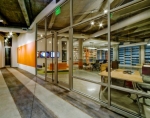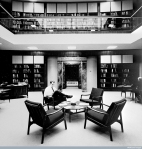What does the physical world around us do to our conversational lives? How do the spaces around us affect our inquisitiveness? Is our creativity hampered or helped by the three dimensional environment? These questions have been popping up regularly over the last couple of years. While I do not have a specific answer, let alone the answer, my next two posts will look at a couple of different perspectives…
Part One: The three dimensional world directly impacts us…
 One of our early Arthaus presenters was Dusty Davidson, a cofounder of the Omaha conference, Big Omaha, which is an event for entrepreneurs, web developers, artists, musicians, innovators and investors. I asked Dusty why they held the two day event at KANEKO, a public non-profit cultural organization dedicated to exploring and encouraging the process of creativity, and how it impacts our lives. The facility is located in three historic warehouse buildings in Omaha’s Old Market District. KANEKO describes its physical space as being as inspiring as its original programming. Dusty’s response was that for Big Omaha to create the kind of accelerated and amplified environment for creativity, a creative space was required. Could not such an environment be conceived within a contemporary convention center, I queried? “No,” was Dusty’s succinct, though considered response.
One of our early Arthaus presenters was Dusty Davidson, a cofounder of the Omaha conference, Big Omaha, which is an event for entrepreneurs, web developers, artists, musicians, innovators and investors. I asked Dusty why they held the two day event at KANEKO, a public non-profit cultural organization dedicated to exploring and encouraging the process of creativity, and how it impacts our lives. The facility is located in three historic warehouse buildings in Omaha’s Old Market District. KANEKO describes its physical space as being as inspiring as its original programming. Dusty’s response was that for Big Omaha to create the kind of accelerated and amplified environment for creativity, a creative space was required. Could not such an environment be conceived within a contemporary convention center, I queried? “No,” was Dusty’s succinct, though considered response.
 Some organizations take deliberate, pro-active steps to engineer a three dimensional environment to catalyze conversational interactions and opportunities for serendipitous creativity. The renowned design thinking consultancy IDEO, for example, incorporates huddle spaces, open plan project centers, and writeable walls as part of the form and function of its building layout. In this sense, the space is as much a tool towards their objectives as are computers, brainstorming techniques, and Post-It Notes. Perhaps the best example of an innovation inducing space is that formulated by Bell Labs. Jon Gertner recounts the Bell Labs story in his book, The Idea Factory, and posits that ideas arise in the frequent, serendipitous encounters between smart, diverse people. In that context, it is clear that connection and innovation best occurs by rendering our physical landscape to promote such interactions and happenstance within an environment architecturally biased towards human preferences and behaviors.
Some organizations take deliberate, pro-active steps to engineer a three dimensional environment to catalyze conversational interactions and opportunities for serendipitous creativity. The renowned design thinking consultancy IDEO, for example, incorporates huddle spaces, open plan project centers, and writeable walls as part of the form and function of its building layout. In this sense, the space is as much a tool towards their objectives as are computers, brainstorming techniques, and Post-It Notes. Perhaps the best example of an innovation inducing space is that formulated by Bell Labs. Jon Gertner recounts the Bell Labs story in his book, The Idea Factory, and posits that ideas arise in the frequent, serendipitous encounters between smart, diverse people. In that context, it is clear that connection and innovation best occurs by rendering our physical landscape to promote such interactions and happenstance within an environment architecturally biased towards human preferences and behaviors.
 There is, though, some difficulty in determining how we may proactively conceive spaces that engender such positive outcomes. The success of Bell Labs or IDEO can be elusive. Open plan office environments may instead, for example, result in higher stress, diminished productivity, and lower satisfaction, as Maria Konnikova points out in her New Yorker piece, The Open-Office Trap. Careful, collaborative consideration has to be given to achieving a balance between new norms of working (nomadic, flexible, group-based, or mobile working), technical demands of the physical environment, the influence of technology, organization objectives, and budgetary factors.
There is, though, some difficulty in determining how we may proactively conceive spaces that engender such positive outcomes. The success of Bell Labs or IDEO can be elusive. Open plan office environments may instead, for example, result in higher stress, diminished productivity, and lower satisfaction, as Maria Konnikova points out in her New Yorker piece, The Open-Office Trap. Careful, collaborative consideration has to be given to achieving a balance between new norms of working (nomadic, flexible, group-based, or mobile working), technical demands of the physical environment, the influence of technology, organization objectives, and budgetary factors.
Recently, I took part in the Omaha Table Talk series, where groups of people sit to table and, over dinner, discuss topics of difference from each of their perspectives. The event serves to encourage engagement and understanding between people of diverse backgrounds, perspectives and experiences. While my Table Talk met those objectives, the vibrancy of the discussion was hindered by the environment. We were hosted by a local college in a student study room. The room’s decor was sterile and, beneath harsh strip lights, we were seated at a large rectangular table that required six of us to sit in a line. Such a configuration felt more like a negotiation than a conversation that nurtured inclusivity.
In their book, Creative Confidence: Unleashing the Creative Potential Within Us All, IDEO leaders David and Tom Kelley direct us to, “Be intentional about your workspace… If you want a team of smart, creative people to do extraordinary things, don’t put them in a drab, ordinary space.” If we want extraordinary conversation, perhaps we must be more intentional about our built and natural environments…

Hey there Stuart, I just put this article on the “What Inspires You?” board at Alley Poyner Macchietto Architecture. Can you send me a high res copy of your logo so I can get that up there too?